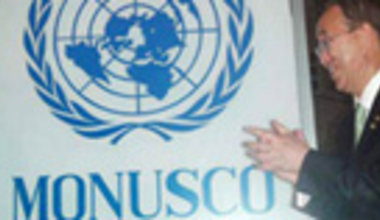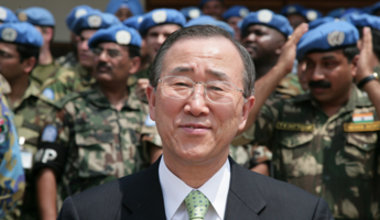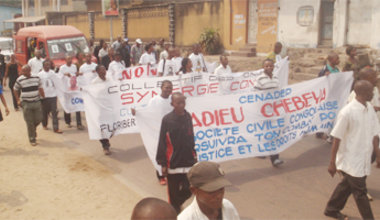3 Mar
2009
Security Council explores new MONUC Deployment Strategy
The United Nations Security Council opens debate, this Wednesday in New York, on the new MONUC mandate and deployment strategy for which the UN Secretary-General requested that the Mission?s strength be doubled from 1st October, Ms. Patricia Tome, Head of MONUC Public Information told the News conference on Wednesday.
Ms. Tome described the UN Secretary-General?s third report on MONUC new deployment strategy in broad outline indicating that MONUC strength be more than doubled to 23,900 troops from the current 10,800.
The objective of this deployment strategy is to make MONUC?s presence more effective in the main areas plagued by instability, since ??MONUC cannot be omnipresent in the Democratic Republic of Congo??, Ms. Tome declared.
Asked about MONUC reaction to RCD?s withdrawal from the Transition, Ms. Tome recalled the CIAT position reflected in its Tuesday communiqué, highlighting that MONUC is part of the above commission. The communiqué appealed to RCD members who suspended their participation in the Transitional Institutions to ??urgently join their respective posts in Kinshasa, the seat of all the Institutions??. The International Committee further ??reiterated that there is no viable alternative to the current Transition?s Process, such as ratified by the All-inclusive Agreement and Constitution?? indicating that ??problems must be resolved within the Transition?s institutions or the appropriate mechanisms put in place in this regard??.
The Head of Public Information also informed the press of a visit by Ugandan high-level delegation in the framework of the Disarmament, Demobilisation, Repatriation, Resettlement and Reintegration (DDRRR) process. ??The objective of the mission is to secure the repatriation of the remaining Sierra Battalion troops, the majority of whom were repatriated to Entebbe by MONUC last December??. About a hundred are in Kananga province where they were assembled by the DRC authorities pending their repatriation to Kampala, she added.
With regard to the military situation, the new MONUC military spokesman, Major François Ouedraogo briefed on MONUC Force commander, General Iliya Samaila?s tour to northeastern DRC, Kivus and Bujumbura. The objectives of the mission was to visit the UN troops and the Congolese officers on the grounds and to talk with his colleague of the UN operation in Burundi (ONUB) which whom he explored the possibility of putting in place a mechanism for cooperation between the two Missions. To this end, Major Ouedraogo announced the reinforcement of the security along the borders between the DRC and Burundi for the prevention of further massacres like the Gatumba?s.
Invited to the press conference, Ms. Megan Scott, OCHA Information Officer, updated on the recent Inter Agencies? humanitarian assistance in Kalehe district, South Kivu. She indicated that last week, the humanitarian community airlifted 62 tonnes of food and non-food stuff to Kalehe peninsula, which it distributed to about 6,000 people. The operation was jointly carried out jointly with PAM, MONUC, World Relief and World Vision, she added, highlighting that ??MONUC logistic support was crucial for the operations??. Ms. Scott seized the opportunity to recall that ??only 42 per cent or 68 million US dollars has thus far been contributed out of the contributions and pledges in the amount of 161 million dollars required in the C.AP.??
MONUC Section of Humanitarian Affairs updated on a report issued by the High Commissioner for Refugees announcing that the Gatumba refugees camp sheltering 8,000 Congolese refugees in Burundi was relocated 50 kilometres away deep in Burundi, under the provisions of the International Humanitarian Law.
Moreover, MONUC proceeds with the airlifting of equipment for the rehabilitation of Kisangani-Lubutu railway. The rehabilitated railway will largely contribute to the transport of humanitarian aid to that part of the country.
The objective of this deployment strategy is to make MONUC?s presence more effective in the main areas plagued by instability, since ??MONUC cannot be omnipresent in the Democratic Republic of Congo??, Ms. Tome declared.
Asked about MONUC reaction to RCD?s withdrawal from the Transition, Ms. Tome recalled the CIAT position reflected in its Tuesday communiqué, highlighting that MONUC is part of the above commission. The communiqué appealed to RCD members who suspended their participation in the Transitional Institutions to ??urgently join their respective posts in Kinshasa, the seat of all the Institutions??. The International Committee further ??reiterated that there is no viable alternative to the current Transition?s Process, such as ratified by the All-inclusive Agreement and Constitution?? indicating that ??problems must be resolved within the Transition?s institutions or the appropriate mechanisms put in place in this regard??.
The Head of Public Information also informed the press of a visit by Ugandan high-level delegation in the framework of the Disarmament, Demobilisation, Repatriation, Resettlement and Reintegration (DDRRR) process. ??The objective of the mission is to secure the repatriation of the remaining Sierra Battalion troops, the majority of whom were repatriated to Entebbe by MONUC last December??. About a hundred are in Kananga province where they were assembled by the DRC authorities pending their repatriation to Kampala, she added.
With regard to the military situation, the new MONUC military spokesman, Major François Ouedraogo briefed on MONUC Force commander, General Iliya Samaila?s tour to northeastern DRC, Kivus and Bujumbura. The objectives of the mission was to visit the UN troops and the Congolese officers on the grounds and to talk with his colleague of the UN operation in Burundi (ONUB) which whom he explored the possibility of putting in place a mechanism for cooperation between the two Missions. To this end, Major Ouedraogo announced the reinforcement of the security along the borders between the DRC and Burundi for the prevention of further massacres like the Gatumba?s.
Invited to the press conference, Ms. Megan Scott, OCHA Information Officer, updated on the recent Inter Agencies? humanitarian assistance in Kalehe district, South Kivu. She indicated that last week, the humanitarian community airlifted 62 tonnes of food and non-food stuff to Kalehe peninsula, which it distributed to about 6,000 people. The operation was jointly carried out jointly with PAM, MONUC, World Relief and World Vision, she added, highlighting that ??MONUC logistic support was crucial for the operations??. Ms. Scott seized the opportunity to recall that ??only 42 per cent or 68 million US dollars has thus far been contributed out of the contributions and pledges in the amount of 161 million dollars required in the C.AP.??
MONUC Section of Humanitarian Affairs updated on a report issued by the High Commissioner for Refugees announcing that the Gatumba refugees camp sheltering 8,000 Congolese refugees in Burundi was relocated 50 kilometres away deep in Burundi, under the provisions of the International Humanitarian Law.
Moreover, MONUC proceeds with the airlifting of equipment for the rehabilitation of Kisangani-Lubutu railway. The rehabilitated railway will largely contribute to the transport of humanitarian aid to that part of the country.
 UN
UN United Nations Peacekeeping
United Nations Peacekeeping



